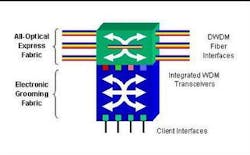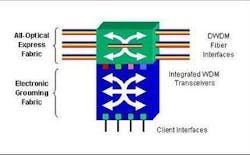The all-optimal switch
Cost-efficient benefits are optimized from optical-electrical combinations in the network
By Joseph Berthold
CIENA Corp.
The appropriate combination of optical and electronic technologies yields networks that significantly lower operational costs at all levels of traffic demand and which scale economically. A new approach to all-optical switching is particularly appealing when deployed in concert with today's state-of-the-art intelligent optical switches. This integrated approach is what might be called "All-Optimal Switching."
Appeal -- and consequences -- of all-optical switching
For many years service providers have been intrigued by the promise of all-optical switching. The basis of the appeal is two-fold. First, all-optical switching could reduce network cost through the elimination of DWDM transceivers, since signals are kept in the optical domain. Second, all-optical switching could speed circuit activation and reduce operations costs as circuits are brought into service or reconfigured. A DWDM channel could be established by introducing new transceivers only at the endpoints of the circuit. No physical equipment installation would be necessary at intermediate nodes in the circuit path.
While all-optical switching is appealing, it brings with it serious constraints. Since signals are kept in the optical domain, and since we do not as yet have satisfactory digital optical logic and memory technologies, all-optical domains are analog transmission domains. Analog transmission engineering is difficult. Analog effects, and especially nonlinear effects, are critical to the design of high-performance optical networks, including both ultra-high-capacity and ultra-long-haul networks. The very action of demultiplexing and multiplexing signals at all-optical switching nodes can add significant impairments and limit the extent of an all-optical domain.
All-optical networks also introduce the wavelength-continuity constraint. Since we do not yet have economically attractive all-optical wavelength converters, a signal must be routed on the same wavelength throughout an all-optical domain. This is a very serious constraint from a networking sense, since an N wavelength DWDM network could be viewed as a set of N isolated sub-networks, each of which has to be planned and provisioned separately. In switching a signal from one link to another, not only does capacity have to be available on alternate links, but also capacity must be available on the same wavelength on alternate links. Strictly all-optical networks are likely to be either underutilized or heavily "blocked."
Considering the appeal of all-optical switching, and aware of the constraints it entails, one is led to conclude that, while not viable as a total networking solution, it is attractive as a component a solution.
Photonic switching doesn't guarantee low cost
One way of managing the constraints of all-optical networking is to use a photonic switch fabric, but by surrounding it with DWDM transceivers. This switch node architecture provides signal regeneration and wavelength conversion, but also eliminates the benefits the all-optical network was supposed to provide. In fact, a photonic switch fabric surrounded by DWDM transceivers requires more optoelectronic conversions than an electronic switch fabric with integrated DWDM transmitters and receivers.
From the point of view of the switch fabric technology itself, photonic switch fabrics are expensive compared with today's high-density silicon switching ASICs. Of particular concern with large 3-D micro-electromechanical system (MEMS) switch fabrics is their non-modular design, which implies a first-installed cost that may be high considering the traffic load the switch may initially need to support. The real benefit of photonic switch fabrics only results from their use in an all-optical networking application.
Role of all-optical switching
The role of electronic switching in networks is well understood. At the edge they are used to switch local traffic, then to aggregate and groom non-local traffic for delivery to their destinations. As traffic traverses the core of a complex network, some optical channels may be terminated at intermediate electronic switching nodes to drop off and pick up traffic. The decision to terminate optical channels at core nodes for switching or to express them through optically is dictated by the traffic demand, both the magnitude and details of the demand pattern.
Additionally, we all know what role we would like all-optical switching to play, but analog impairments and wavelength-continuity constraints sometimes get in the way. We would all like all-optical switches to create direct optical connections between electronic switches when the traffic demand between those switches has reached the point that it justifies a dedicated optical channel. The path of the optical channel may traverse many intermediate nodes that contain electronic switches, but those switches may be optically bypassed when there is no value to be added by signal termination. This both saves cost and extends the time at which electronic switch capacity must be increased.
In a sense, electronic switching is a key enabling technology of all-optical networking. An integrated control plane is required to deliver the most value from the combination of electronic and all-optical switching.
A fresh approach to photonic switching
The ideal photonic switching technology would be one that is minimally disruptive to express traffic, with signals remaining in the optical domain as they traverse a switching node. For scalability purposes the cost and complexity related to express optical channel management would ideally remain low, and relatively independent of the number of express channels. It is more acceptable, from a value perspective, to incur cost proportional to the amount of traffic terminating at a node, rather than for all traffic transiting a node.
The broadcast-and-select switch architecture described in Reference 1 (Figure 1) has these attributes. The switch described there is a reconfigurable OADM. However, in a more generalized broadcast-and-select switch architecture, each transit output port selects the traffic it will forward from copies of the traffic on each input port, appropriately filtered by a high-resolution dynamic spectral equalizer. Another way to describe the switching action is to call it a spectral exchange switch, as arbitrary patterns of optical spectrum are exchanged among the switch ports.
The economic attraction of this new "all-optimal" switching approach lies in the simplicity with which it scales to high wavelength count, and therefore high network capacity. Current technology supports 50-GHz channel spacing, or 96-channel DWDM systems. At 25-GHz spacing it supports 192-channel DWDM systems. Moving from 50- to 25-GHz resolution is a design decision that must be made, but once made does not result in proportionally higher manufacturing cost. Contrast this with photonic space-division switches, where cost is proportional to port count.
An intelligent optical switch would rely on this type of all-optical switch functionality to create express optical paths through the network when the traffic load warrants such action. The all-optical switch would work in concert with an optical-to-electrical-to-optical (OEO) -based switch to select optimal locations for signal regeneration and wavelength conversion when express optical channels require them, such as at the edge of all-optical domains. This new model of all-optical switching provides a valuable new component of the intelligent optical network, a component that will be crucial to the economic scaling of network capacity in the future.
Joe Berthold is vice president of network architecture for CIENA Corp. in Linthicum, MD. He is also on the Optical Interoperability Forum (OIF) Board of Directors, and was the OIF's Technical Committee chairman until recently.

